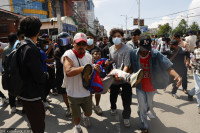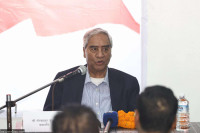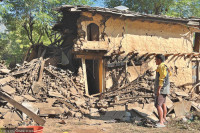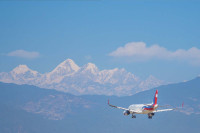Editorial
Running out of road
Cities of the future need to invest more in alternative modes of transport.
The mismatched policy of allowing the number of vehicles to balloon out of control while neglecting investment to upgrade and add to the existing infrastructure has caused havoc on the streets of Kathmandu. There are 1.75 million vehicles that ply the streets of the valley currently, an increase of 25 percent from just a year ago, when the number stood at 1.4 million. By 2016, there were already so many automobiles that if all of them were arranged in a single file bumper to bumper, the line would be longer than the length of the roads in Kathmandu Valley by one and a half times. It’s safe to assume that the situation has only worsened since.
Investment in upgrading the existing infrastructure is abysmal as it is. As of 2020, of the 13,232 km of roads in Kathmandu Valley, only 4,073 km had been blacktopped, and there is not a single flyover. Haphazard urbanisation has made it virtually impossible for any widening of roads or improvement at junctions. And then there is the issue of malfunctioning traffic lights—the signals in themselves would not aid in easing congestion but would, to a certain extent, allow for smooth traffic flow. But more importantly, there is an urgent need among motorists to adhere to traffic rules. Avoiding erratic driving and possessing a general sense of traffic rules would further manage the traffic mess rather than a few functioning traffic lights.
If the growth in the number of vehicles is allowed to continue at the current trend without a well-thought-out investment in mass transit infrastructure, the outcome would undoubtedly be cataclysmic. Cities of the future need to invest more in alternative modes of transport and not just concentrate on increasing the number of vehicles. Streets need to be prioritised not just for moving vehicles, but for moving people as well. Substantial pedestrian facilities would allow for fewer obstructions for moving vehicles and keep the streets safer and less prone to accidents.
The issue is not something the authorities can simply sweep under the rug. The more we procrastinate on it, the worse it will get. We need a farsighted approach to planning and implementation. Cosmetic road works alone will not solve the problem. Decisions taken today will have ramifications for many years; hence, plans must incorporate urban development programmes for at least the next 50 years. Issues such as these do not possess the ability to find easy solutions. If not acted on immediately, the traffic snarls will only become more acute.




 11.12°C Kathmandu
11.12°C Kathmandu












%20(1).jpg&w=300&height=200)

